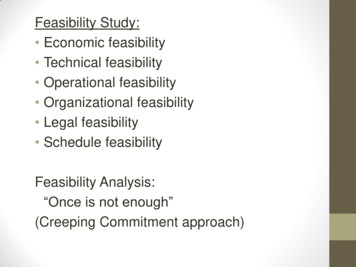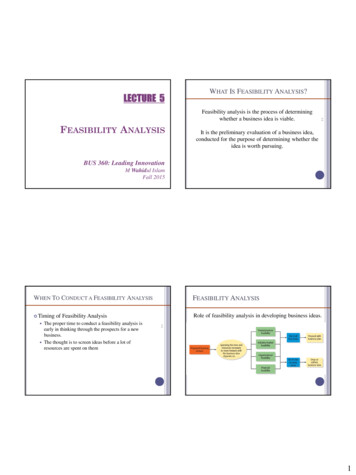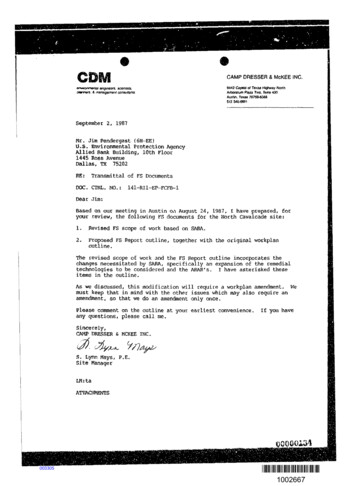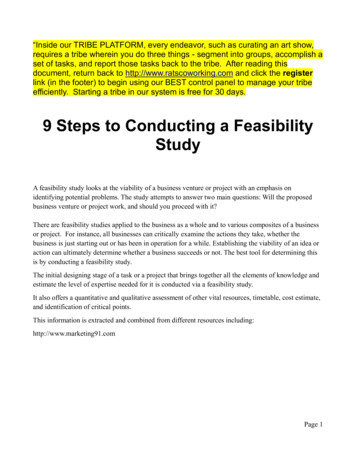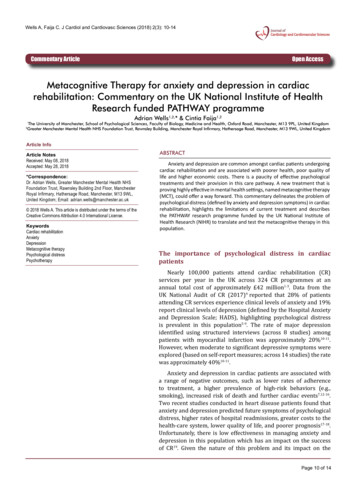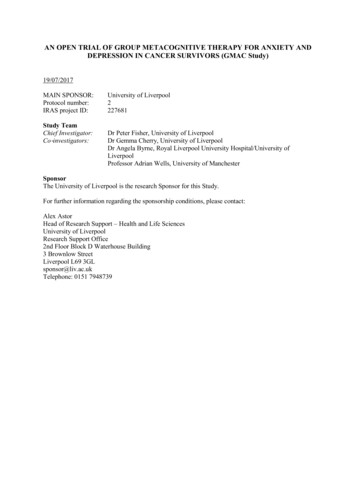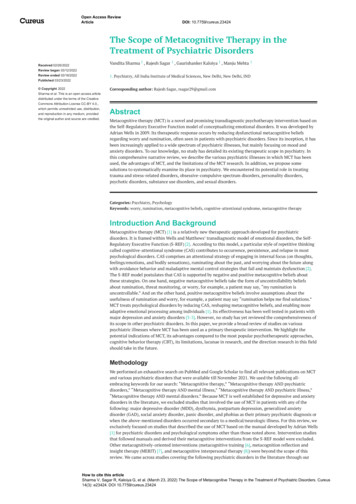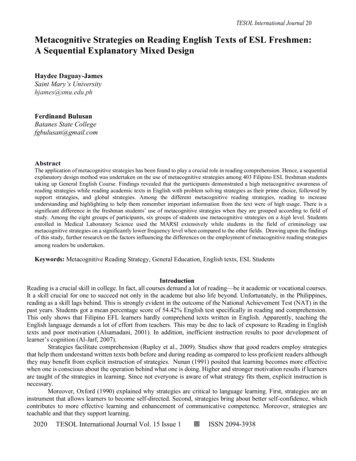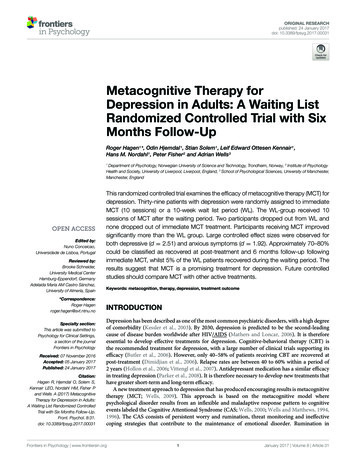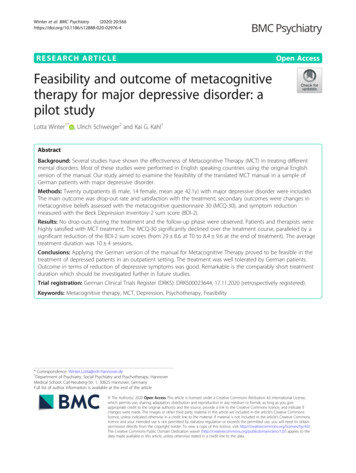
Transcription
Winter et al. BMC Psychiatry(2020) SEARCH ARTICLEOpen AccessFeasibility and outcome of metacognitivetherapy for major depressive disorder: apilot studyLotta Winter1* , Ulrich Schweiger2 and Kai G. Kahl1AbstractBackground: Several studies have shown the effectiveness of Metacognitive Therapy (MCT) in treating differentmental disorders. Most of these studies were performed in English speaking countries using the original Englishversion of the manual. Our study aimed to examine the feasibility of the translated MCT manual in a sample ofGerman patients with major depressive disorder.Methods: Twenty outpatients (6 male, 14 female, mean age 42.1y) with major depressive disorder were included.The main outcome was drop-out rate and satisfaction with the treatment; secondary outcomes were changes inmetacognitive beliefs assessed with the metacognitive questionnaire 30 (MCQ-30), and symptom reductionmeasured with the Beck Depression Inventory-2 sum score (BDI-2).Results: No drop-outs during the treatment and the follow-up phase were observed. Patients and therapists werehighly satisfied with MCT treatment. The MCQ-30 significantly declined over the treatment course, paralleled by asignificant reduction of the BDI-2 sum scores (from 29 8.6 at T0 to 8.4 9.6 at the end of treatment). The averagetreatment duration was 10 4 sessions.Conclusions: Applying the German version of the manual for Metacognitive Therapy proved to be feasible in thetreatment of depressed patients in an outpatient setting. The treatment was well tolerated by German patients.Outcome in terms of reduction of depressive symptoms was good. Remarkable is the comparably short treatmentduration which should be investigated further in future studies.Trial registration: German Clinical Trials Register (DRKS): DRKS00023644, 17.11.2020 (retrospectively registered).Keywords: Metacognitive therapy, MCT, Depression, Psychotherapy, Feasibility* Correspondence: Winter.Lotta@mh-hannover.de1Department of Psychiatry, Social Psychiatry and Psychotherapy, HannoverMedical School, Carl-Neuberg-Str. 1, 30625 Hannover, GermanyFull list of author information is available at the end of the article The Author(s). 2020 Open Access This article is licensed under a Creative Commons Attribution 4.0 International License,which permits use, sharing, adaptation, distribution and reproduction in any medium or format, as long as you giveappropriate credit to the original author(s) and the source, provide a link to the Creative Commons licence, and indicate ifchanges were made. The images or other third party material in this article are included in the article's Creative Commonslicence, unless indicated otherwise in a credit line to the material. If material is not included in the article's Creative Commonslicence and your intended use is not permitted by statutory regulation or exceeds the permitted use, you will need to obtainpermission directly from the copyright holder. To view a copy of this licence, visit http://creativecommons.org/licenses/by/4.0/.The Creative Commons Public Domain Dedication waiver ) applies to thedata made available in this article, unless otherwise stated in a credit line to the data.
Winter et al. BMC Psychiatry(2020) 20:566BackgroundMetacognitive Therapy (MCT) by Wells [19] describes atheory-based psychotherapy that can be applied in thetreatment of several mental disorders. The treatmentbased on the self-regulatory model [21] aims to supportthe patient regain flexible attention by modulating metacognitive beliefs and reducing perservative thinkingstyles. In comparison to other treatments, it does notfocus on content of thoughts or increasing mastery andpleasure, but on reducing unhelpful cognitive processesand facilitating metacognitive modes of processing.Results of MCT studies demonstrated considerably shorttreatment durations (10–12 sessions), large effect sizesand trans-diagnostic effects, as well as low drop-outrates indicating the treatment, is well tolerated, feasibleand effective [4, 11]. Meanwhile, disorder specific caseformulations and therapy plans have been developed forpsychiatric disorders such as major depressive disorder,obsessive-compulsive disorder, generalized anxiety disorder,post-traumatic stress disorder [19] and social phobia [10],and further indications such as borderline personalitydisorder [9], addictive disorders [17] or psychotic disorders[15] are in development. A recent meta-analysis demonstrated superior efficacy of MCT compared to cognitive behavioral therapy (pooled effect sizes (Hedges’g) of 0.69 and0.37 and post-treatment and follow-up), indicating thatMCT might be an interesting candidate for future psychotherapeutic advances [11].MCT is spread in Great Britain and the Scandinaviancountries; however, current use in Germany is extending. Considering feasibility aspects in studies in whichthe original manual was used, it can be found that thetreatment leads to symptom improvement and that lowdrop-out rates are reported [3, 8, 19]. Feasibility of MCTas delivered using the German translation of the MCTmanual [20] has yet to be evaluated. Although beingFig. 1 consort diagram of trial procedurePage 2 of 7manualized, the flexible application of MCT strategies isessential to fit the specific patient’s needs. The exact caseformulation, as well as individual combination of exercises and metaphors vary. In contrast, the first step in therapy generally is to conceptualize and socialize the patient tothe maintaining processes. Profound expertise is needed toapply MCT as intended. Therefore, the aim of this studywas to perform the first feasibility study on MCT in majordepressive disorder in Germany. We focused particularlyon drop-outs as a measure of acceptability and adherenceto treatment. Secondary outcome measures were used togather indicators for treatment effects.MethodsRecruitmentAll patients were recruited from a waiting list of thepsychotherapy outpatient clinic of the Department ofPsychiatry, Social Psychiatry, and Psychotherapy of theHannover Medical School. They were either referred bylocal psychiatrists, local general practitioners, or fromother Departments of the Hannover Medical School. Allpatients gave written informed consent to participate inthe study. As recruitment was not standardized but anypatient who contacted the outpatient clinic reportingdepressive symptoms was offered to take part in a screeninginterview, recruitment rates cannot be reported. Figure 1shows the consort diagram of the procedure.SampleTwenty patients with major depressive disorder (MDD)were included after written informed consent. MDDdiagnosis was confirmed using a structured clinicalinterview according to DSM-IV [24], and depressionseverity was assessed using the German version of theBeck Depression Inventory-II [5].
Winter et al. BMC Psychiatry(2020) 20:566Page 3 of 7Exclusion criteria were current diagnosis of a substance use disorder, psychotic disorder, bipolar disorder,any personality disorder, cognitive impairment, andacute medical conditions. To exclude patients with theaforementioned disorders, the complete structured clinicalinterview for DSM-IV was applied (SCID-1 and SCID-2).Patients who were on antidepressant medication whenentering the study had to be on the same doses for thepast 3 months and to agree to keep the dose stable untilthe end of therapy.Table 1 presents more information on samplecharacteristics.Assessment of depression severity and qualitative ratingsMCT specific measurementsPatients questions included:For the measurement of metacognitions, the Germanversions of the Metacognition questionnaire (MCQ-30,[20]) as well as the Positive Believes about RuminationScale (PBRS, [13]) and the Negative Believes aboutRumination Scale (NBRS, [14]) were administered. TheMCQ-30 assesses levels of metacognitive beliefs. It has30 items rated 1–4, with higher scores indicating higherlevels of maladaptive metacognitions. Scores range from30 to 120. The psychometric properties are adequat withCronbach’s alpha for the total score of 0.88 [18]. ThePBRS assesses beliefs about the advantages of rumination. It has nine items rated 1–4, and scores range from9 to 36. Psychometric properties are good with a Cronbach’s alpha of 0.89 [7]. The NBRS assesses beliefs aboutuncontrollability and harm as well as interpersonal consequences. It has 13 items rated 1–4, and scores from 12to 52. Good psychometric properties have been reportedwith Cronbach’s alpha of 0.83 [7].Table 1 Baseline demographics and sample characteristicscharacteristicsN 20Age, years (SD)42.1 (9.2)Gender, female/male14/6Partnered/single10/10Working/ not working18/2Diagnosis of depressionsingle depressive episode8recurrent major depressive disorder12Comorbid diagnosis5Panic disorder2General anxiety disorder1Obsessive-compulsive disorder1Post-traumatic stress disorder1Antidepressant medication11SSRI8SNRI3The severity of depressive symptoms was measuredusing the BDI-2. It has 21 items rated 0 to 3. The totalscore indicates the extent of depressive symptoms. 0 to8 points to the prevalence of no, 9 to 13 of minimal, 14to 18 of mild, 19 to 29 of moderate and 30 to 63 ofsevere depressive symptoms. Good psychometric properties have been reported with a Cronbach’s alpha of 0.93.To receive qualitative feedback on the experience ofMCT the patients and therapists were asked to reply totwo qualitative questions about the therapy process byrating on a visual analogue scale at T1.1. How satisfied were you overall with your therapy?2. Considering what you learned from therapy how helpful was theinput to reach your personal therapy goals?Questions for therapists included:1. How satisfied were you overall with the therapy?2. How helpful you think was the input you gave for the patient toreach personal therapy goals?These qualitative questions could be answered with theuse of a 10 cm long visual analogue scales ranging from “notat all” (0) to “very much” (9). Patients received thesequestions by their therapists after the last psychotherapeuticsession (T1), and the psychotherapists received thequalitative questions by the study leader after the lasttreatment session. Results are are listed in Figs. 2 and 3.AssessmentsAll study participants were assessed before (T0) and after(T1) the treatment, as well as 6 months after therapyended (T2). The primary outcome parameter in this prepost-follow-up comparison was the drop-out rate as an indicator of how well the treatment was tolerated. Secondaryoutcomes included a change of metacognitive beliefs(MCQ-30, PBRS, NBRS) and symptom reduction (BDI-2).MCT treatment and therapistsAll MCT therapists were graduates of the MCT Institute(www.mct-instiute.com) diploma. They were underregular supervision to ensure the quality of the deliveredtreatment. No formal measures of therapists’ competence,treatment integrity, or adherence were applied.The therapy followed the translated manual andsession guide of MCT in depression for individualtreatment that was evaluated in our study [20]. In brief,the therapy plan consisted of conceptualization of a caseformulation and socialization of the metacognitivemodel and mechanisms. The next step was to increasemeta-awareness by identifying thoughts that act as triggers for rumination, initiating metacognitive control
Winter et al. BMC Psychiatry(2020) 20:566Page 4 of 7Fig. 2 Means and standard deviation of the qualitative ratings of the patients on a visual analogue scalewith the use of the attention training technique, andintroducing detached mindfulness. Throughout the therapy, beliefs about the uncontrollability of ruminationand worry and about threat monitoring and danger ofrumination got challenged. Positive beliefs about rumination and worry were modified before relapse preventionwas preceded. As the study was part of routine clinicalservice, therapy was terminated when individual treatment goals were reached, and the therapist and patientagreed on the end of therapy. All patients were treatedin individual sessions with a duration of 50 Minuteseach.performed to analyze differences between different timepoints. To define which time point differed significantlyDunn-Bonferroni test was performed as a post-hoc test.Bonferroni corrections were applied when indicated. Todetermine the value of the results effect sizes were calculated using Pearson’s correlations (r) which is the commonway in the context of Friedman test statistics. r 0.10 indicates a small, r 0.30 a medium and r 0.5 a large effect[1].Descriptive analysis was performed for the wholegroup concerning age, gender, marital status, workstatus, comorbidity and visual analogue scales of thequalitative questions.StatisticsData were analyzed using IBM SPSS (version 24). As theKolmogorov-Smirnov test did not reveal normal distribution at all time points, and the sample was smallerthan n 30, the non-parametric Friedman test wasResultsPrimary outcomeAll 20 patients finished MCT after an average treatmentduration of 10 sessions (SD 4.2). None of the patientsFig. 3 Means and standard deviations of the qualitative ratings of the therapists on a visual analogue scale
Winter et al. BMC Psychiatry(2020) 20:566Page 5 of 7dropped out, and all of them finished the T3 visit after6 months. Only one dataset showed missing values. Noadverse events were observed.Qualitative ratings of the individual experiences withMCT in patients and therapists revealed a high extent ofsatisfaction, and a high valuation of the therapeuticinput to reach personal therapy goals (Figs. 2 and 3).Secondary outcomeTable 2 presents data of all secondary outcome measures.Considering the change of metacognitive beliefs, significantreductions could be found on all three scales (MCQ-30,PBRS, NBRS) by using the Friedman-Test. Changes on theMCQ-30 and PBRS showed significant reductions in thepre to post as well as the pre to follow-up comparison. Thesum score of the NBRS reduced significantly in the pre tofollow-up comparison. NBRS changes in the pre to postcomparison revealed a large effect size, but the reductionwas not significant.The Friedman-Test revealed a significant reduction inBDI-2 sum-scores over time. The Dunn-BonferroniTests indicate significance in the pre to post-therapycomparison as well as the pre to follow-up comparison.Effect sizes for both comparisons are large.Figure 4 shows that courses of BDI-2 scores andMCQ-30 scores are similar.DiscussionWe here demonstrate the feasibility of the Germanversion of the MCT manual in patients with majordepressive disorder. None of the patients dropped outor requested a change of therapy, and patients werehighly satisfied with MCT treatment. These findingsare in line with feasibility studies on the originalmanual [3, 8, 19].Results from the secondary outcomes providepreliminary indications of efficacy of MCT in depressivepatients, demonstrated by a significant reduction in BDI-2scores after the end of treatment. In line with the assumption that changes in metacognitive beliefs underlie theantidepressive effect of MCT, the MCQ-30 sum scoredeclined significantly (Fig. 1). Concerning lasting effects ofMCT treatment, BDI-2 sum scores further declined at lastfollow-up 6 months after the end of treatment, Further, allpatients who were classified as remitters ( 50% symptomreduction in BDI-2 sum score) at the end of treatmentwere still in remission at follow-up after 6 months.Our results are in accordance with others demonstratingthe clinical efficacy of MCT [2, 6, 16, 22]. A recent metaanalysis integrating data of 15 trials demonstratedlarge effect sizes of MCT against waitlist condition(Hedges’ g 2.06), and even superior pooled effectsizes compared to cognitive and behavioralinterventions at post-treatment and at follow-up(Hedges’ g 0.69 and 0.37 respectively) [11].Given the high level of health care expenditure forpatients with major depressive disorder, our findingssuggest a potential time effectiveness of this therapeuticintervention. For the treatment of depression, themanual suggests 8 to 10 sessions. In our trial, averagetreatment duration was ten sessions. Compared to otherpsychotherapies, such as cognitive-behavioral therapy(CBT) or psychodynamic therapy, treatment durationseems shorter in MCT. A recent study demonstratedthat in general the average treatment duration of CBT is40 sessions and of psychodynamic therapy is 62 sessions[12]. One possible explanation for the comparably smallnumber of sessions needed in MCT is that underlyingprocesses are modified rather than content or schemarelated aspects of a disorder [23].Limitations: The lack of a control group, the limitednumber of patients and the individual medication historieshampered the interpretation of the data. In addition theremight be a selection bias as we can not rule out that patientswith benevolent attitudes concerning psychotherapy weremainly included. The observation period was relatively shortdue to the feasability study design. Further studies shouldinclude long-term observations to rule out short-term positive effects of MCT treatment. Pharmacotherapy – althoughguideline-based – could not be standardized during the studyand might have affected treatment outcome. However, morestudies with greater cohorts of patients, directly comparingdifferent psychotherapeutic methods are warranted. Inaddition, future studies should evaluate the quality criteria ofthe translated questionnaires and use formal measures oftherapists’ competence and adherence.Table 2 Data of all secondary outcome nferroni-Testsand effect sizesT0-T1Dunn-Bonferroni-Testsand effect sizesT0-T261.4 12.949.5 10.845.5 10.4χ2(2) 24.4, p 0.01z 2.7, p 0.05; r 0.6z 4.9, p 0.01, r 1.1PBRS20.8 5.514.4 6.713.7 7.1χ (2) 14.4, p 0.01z 2.7, p 0.05; r 0.6z 3.4, p 0.01, r 0.8NBRS26.9 6.621 5.619.3 6χ2(2) 12.2, p 0.01z 2.2, p 0.09, r 0.5z 3.4, p 0.01, r 0.8BDI-229 8.613 8.48.4 9.6χ2(2) 33.6, p 0.01z 3.8, p 0.01; r 0.8z 5.7, p 0.01; r 1.32MCQ-30 Metacognitions Questionnaire-30, PBRS Positive beliefs about rumination scale, NBRS negative beliefs about rumination scale, BDI-2 BeckDepression Inventory-2
Winter et al. BMC Psychiatry(2020) 20:566Page 6 of 7Fig. 4 courses of BDI-2 scores and MCQ-30 scoresConclusionsApplying the German version of the manual forMetacognitive Therapy is feasible in the treatment ofdepressed patients in an outpatient setting. The treatmentwas well tolerated by German patients and accounted ashelpful by the therapists. Outcome in terms of reductionof metacognitive beliefs and depressive symptoms wasgood. Remarkable is the comparably short treatmentduration which should be investigated further in futurestudies.AbbreviationsMCT: Metacognitive Therapy; MCQ-30: Metacognitions questionnaire 30; BDI2: Beck Depression Iventory-2; MDD: Major depressive disorder; SCID1: Structural clinical interview for DSM-IV; SCID-2: Structural clinical interviewfor DSM-IV; PBRS: Positive beliefs about rumination scale; NBRS: Negativebeliefs about rumination scale; CBT: Cognitive behavioral therapy; VAS: Visualanalogue scaleAcknowledgementsWe thank Janina Nielsen and Julia Gottschalk for their assistance. We aregrateful for Adrian Wells supervising and supporting us throughout thewhole study. Further, we thank the patients for participating in the study.Authors’ contributionsAll authors designed the original concept. LW was part of the teamrecruiting the patients, carrying out the assessments and therapies. US andKGK supervised the procedures. All authors conducted the data analysis andwrote the paper. The author(s) read and approved the final manuscript.FundingThere was no funding for this study. Open Access funding enabled andorganized by Projekt DEAL.Availability of data and materialsThe datasets used and analysed during the current study are available fromthe corresponding author on reasonable request.Ethics approval and consent to participateThe study was approved by the local ethics committee of Hannover MedicalSchool (No. 1343–2012). All patients gave written informed consent toparticipate.Consent for publicationNot applicable.Competing interestsThe authors declare that they have no competing interests.Author details1Department of Psychiatry, Social Psychiatry and Psychotherapy, HannoverMedical School, Carl-Neuberg-Str. 1, 30625 Hannover, Germany. 2HeliosHanseklinikum Stralsund, Große Parower Str. 47-53, 18435 Stralsund,Germany.Received: 30 July 2020 Accepted: 18 November 2020References1. Cohen J. A power primer. Quant Meth Psychol. 1992;112:155–9.2. Dammen T, Papageorgiou C, Wells A. A Two Year Follow up Study of GroupMetacognitive Therapy for Depression in Norway. J Depress Anxiety. 2016;52:227.3. Fisher PL, Wells A. Metacognitive therapy for obsessive-compulsive disorder:a case series. J Behav Ther Exp Psychiatry. 2008;39:117–32.4. Hagen R, Hjemdal O, Solem S, Kennair LEO, Nordahl HM, Fisher P, et al.Metacognitive Therapy for Depression in Adults: A Waiting List RandomizedControlled Trial with Six Months Follow-Up. Front Psychol. 2017;8:31.5. Hautzinger M, Keller F, Kuehner C. Beck-depressions-Inventar: revision.Frankfurt: Harcourt Test Services; 2006.6. Hjemdal O, Solem S, Hagen R, Kennair LEO, Nordahl HM, Wells A. Arandomized controlled trial of metacognitive therapy for depression:analysis of 1-year follow-Up. Front Psychol. 2019;10:1842.7. Luminet O. Assessment and measurement of rumination. In: PapageorgiouC, Wells A, editors. Rumination: Nature, Theory, and Treatment of NegativeThinking in Depression. Chichester: Wiley; 2004. p. 187–215.8. Morrison AP, Pyle M, Chapman N, French P, Parker SK, Wells A.Metacognitive therapy in people with a schizophrenia spectrum diagnosis
Winter et al. BMC .23.24.(2020) 20:566and medication resistant symptoms: a feasibility study. J Behav Ther ExpPsychiatry. 2014;45(2):280–4.Nordahl HM. The ERIS protocol. MCT for Borderline Personality. Manchester:Paper presented at the MCT conference; 2011.Nordahl H, Wells A. Testing the metacognitive model against thebenchmark CBT model of social anxiety disorder: Is it time to move beyondcognition. PLoS One. 2017;125:e0177109.Normann N, Morina N. The efficacy of metacognitive therapy: a systematicreview and meta-Analysis. Front Psychol. 2018;9:2211.Nübling, R., Jeschke, K., Ochs, M., and Schmidt, J. (2014). Zur ambulantenpsychotherapeutischen Versorgung in Deutschland. Eine Befragung vonPsychotherapeutinnen und Psychotherapeuten in fünf Bundesländern als einBeitrag zur psychotherapeutischen Versorgungsforschung 2014, DPTVDPTV.Papageorgiou C, Wells A. Positive beliefs about depressive rumination:development and preliminary validation of a self-report scale. Behav Ther.2001a;32:1. georgiou C, Wells A. Metacognitive beliefs about rumination inrecurrent major depression. Cogn Behav Pract. 2001b;8:2. er SK, Mulligan LD, Milner P, Bowe S, Palmier-Claus JE. Metacognitivetherapy for individuals at high risk of developing psychosis: a pilot study.Front Psychol. 2020;10:2741. https://doi.org/10.3389/fpsyg.2019.02741.Solem S, Kennair LEO, Hagen R, Havnen A, Nordahl HM, Wells A, et al.Metacognitive therapy for depression: a 3-year follow-up study assessingrecovery, relapse, work force participation, and quality of Life. Front Psychol.2019;10:2908.Spada MM, Wells A. A metacognitive model of problem drinking. ClinPsychol Psychother. 2009;165:383–93.Spada MM, Mohiyeddini C, Wells A. Measuring metacognitions associatedwith emotional distress: factor structure and predictive validity of themetacognitions questionnaire 30. Personal Individ Differ. 08.04.005.Wells A. Metacognitive therapy for anxiety and depression. New York:Guilford Press; 2009.Wells A. Metakognitive Therapie bei Angststörungen und Depression.Weinheim: Beltz; 2011.Wells A, Matthews G. Attention and emotion: a clinical perspective. Hove:Erlbaum; 1994.Wells A, Fisher P, Myers S, Wheatley J, Patel T, Brewin CR. Metacognitivetherapy in treatment-resistant depression: a platform trial. Behav Res Ther.2012;506:367–73.Winter L, Gottschalk J, Nielsen J, Wells A, Schweiger U, Kahl KG. Acomparison of metacognitive therapy in current versus persistentdepressive disorder - a pilot outpatient Study. Front Psychol. 2019;10:1714.Wittchen H, Zaudig M, Fydrich T. SKID-I und SKID-II. Strukturiertes KlinischesInterview für DSM-IV. Göttingen: Hogrefe; 1997.Publisher’s NoteSpringer Nature remains neutral with regard to jurisdictional claims inpublished maps and institutional affiliations.Page 7 of 7
The therapy followed the translated manual and session guide of MCT in depression for individual treatment that was evaluated in our study [20]. In brief, the therapy plan consisted of conceptualization of a case formulation and socialization of the metacognitive model and mechanisms. The next step was to increase
